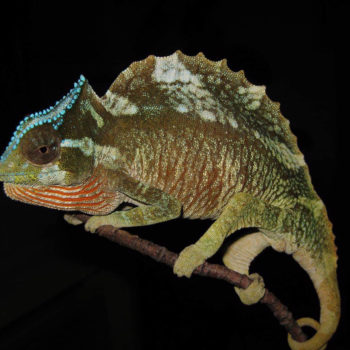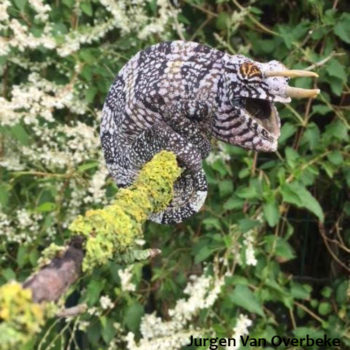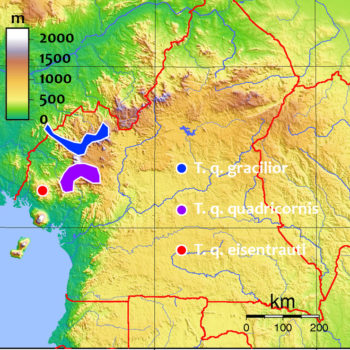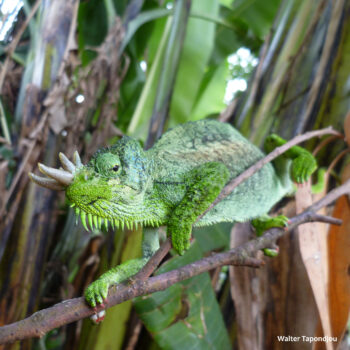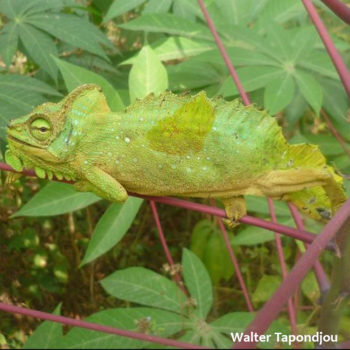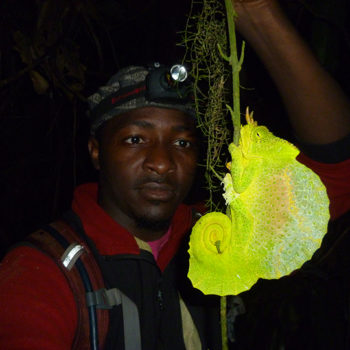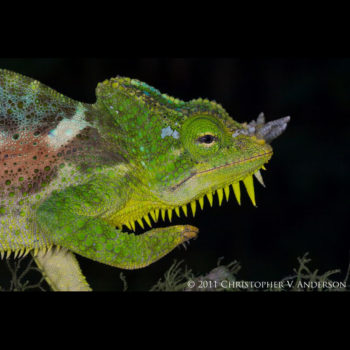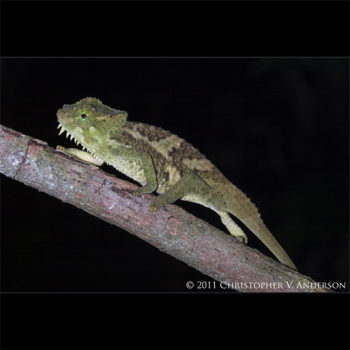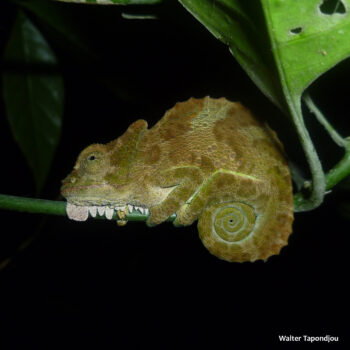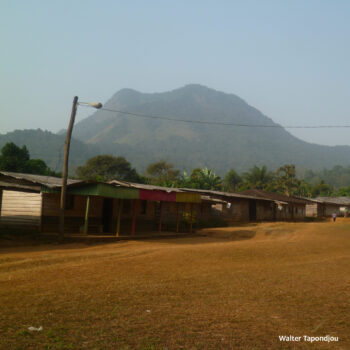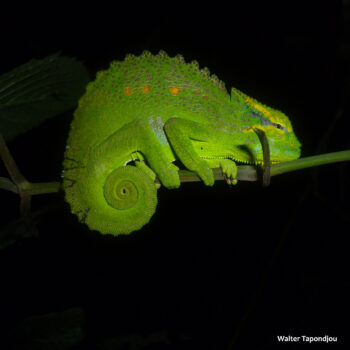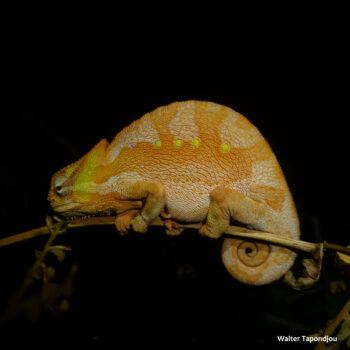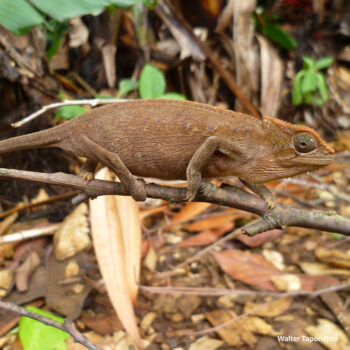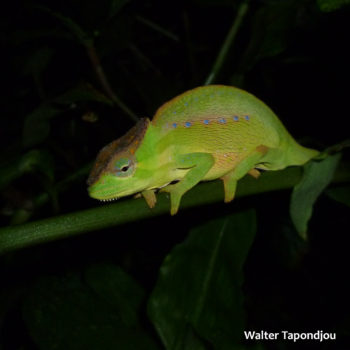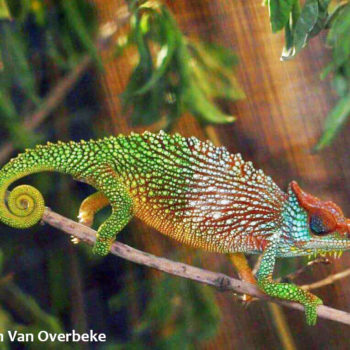Enjoy this tour of Cameroon Chameleon Species!
Rampholeon spectrum
Rampholeon spectrum is a pygmy chameleon that is wide spread across the countries in West Africa. They inhabit the lowlands, but Walter explains how he was surprised to see how high in elevation they actually occur.
These cryptic chameleons are colored to blend in with the leaf litter on the ground. Their tail is not prehensile and their arboreal activity is limited to a meter above the ground.
Trioceros cristatus
Trioceros cristatus is widespread across the west African countries. It is a lowland species and tends to be active in the ;lower level of the bushes and trees.
This species is distinct in that the males are a rich chestnut color with a blue ring around the crown of their head while the females are a bright green color. This, of course, makes sexing very easy.
Trioceros oweni
Trioceros oweni is a lowland species and lives high in the canopy making studying them challenging! The males have three horns while the female is without horns. An exceptional feature of this species is the very long tail which helps them navigate the tree tops.
Trioceros montium
Trioceros montium is a mid-elevation species. The males have two prominent rostral horns. T. montium can be identified by the large scales that are sprinkled on their flanks. Though the males are obvious with their two horns and sail down their backside, the females have neither horns nor sail.
Trioceros quadricornis
Trioceros montium is a mid-elevation species. The males have two prominent rostral horns. T. montium can be identified by the large scales that are sprinkled on their flanks. Though the males are obvious with their two horns and sail down their backside, the females have neither horns nor sail.
Trioceros quadricornis quadricornis
Trioceros montium is a mid-elevation species. The males have two prominent rostral horns. T. montium can be identified by the large scales that are sprinkled on their flanks. Though the males are obvious with their two horns and sail down their backside, the females have neither horns nor sail.
Trioceros quadricornis gracilior
Trioceros montium is a mid-elevation species. The males have two prominent rostral horns. T. montium can be identified by the large scales that are sprinkled on their flanks. Though the males are obvious with their two horns and sail down their backside, the females have neither horns nor sail.
Trioceros quadricornis eisentrauti
Trioceros quadricornis eisentrauti is a rarely seen subspecies of T. quadricornis. They exist in a small area on Mt. Rumpi. Although the males have both the back and tail sail fins, they do not have the nose horns that are characteristic of the other quadricornis subspecies.
This subspecies requires undisturbed forest and so is more precarious in their threatened status.
Trioceros serratus
Trioceros serratus is a wide ranging species found on Mt. Oku and Mt. Lefo and ranges into Nigeria. It inhabits elevations at 1500m to 2700m. It was separated from Trioceros wiedersheimi in 2010.
Trioceros perreti
Trioceros perreti is a small, colorful chameleon found only on Mt. Manengouba. It inhabits elevations between 1300 – 2400 meters above sea level. This was once considered a subspecies of Trioceros wiedersheimi but in 2010 was granted full species status.
Trioceros wiedersheimi
Trioceros wiedersheimi is found in the northwest highlands of Cameroon and is found between 1500 and 2450 meters above sea level. It is very similar to T. perreti and T. serratus and it was only in 2010 that the three were separated into different species. But while T. serratus and T. perreti are found in the Southeast Cameroon highlands, T. wiedersheimi is found in the mountain ranges north of Mt. Oku going through the Nigerian side and into the northern half of the volcanic mountain range.
Trioceros pfefferi
Trioceros pfefferi is the smallest of the horned species of Cameroon. They are difficult to study due to their habit of perching high in the trees. They inhabit undisturbed forest and do not adjust well to human encroachment and farmland.
Other Chameleon Species
Cameroon is also home to the following species:
Chamaeleo africanus: This species can be found across Africa and into Europe with an introduced population in Greece. It is a hardy species which can inhabit disturbed areas. Its range touches on Cameroon in the Northeastern tip.
Chamaeleo dilepis: One of the widest distributed species across the southern half of Africa, Ch. dilepis has many recognized forms. Males can be identified by tarsal spurs like is seen in the more well known Veiled Chameleon. In Cameroon it is found on the southern edge of the country along the border with Gabon.
Chamaeleo gracilis gracilis: This species is distributed across the belt of central Africa. In the Cameroon, it is found both in the western coastal regions and in the eastern savannahs. Males can be identified by a tarsal spur.
Chamaeleo senegalensis: Found from 0 to 2000 meters above sea level, Ch. senegalensis is found in many areas across the center of Cameroon. Its range also extends into countries along the Western Atlantic African countries. Males are not easily distinguished from females except for being larger when full grown.
Trioceros camerunensis: This is a lowland species that is found in Cameroon, Equitorial Guinea, and Gabon. It is found up to 700 meters in the same areas as T. cristatus and T. oweni.


